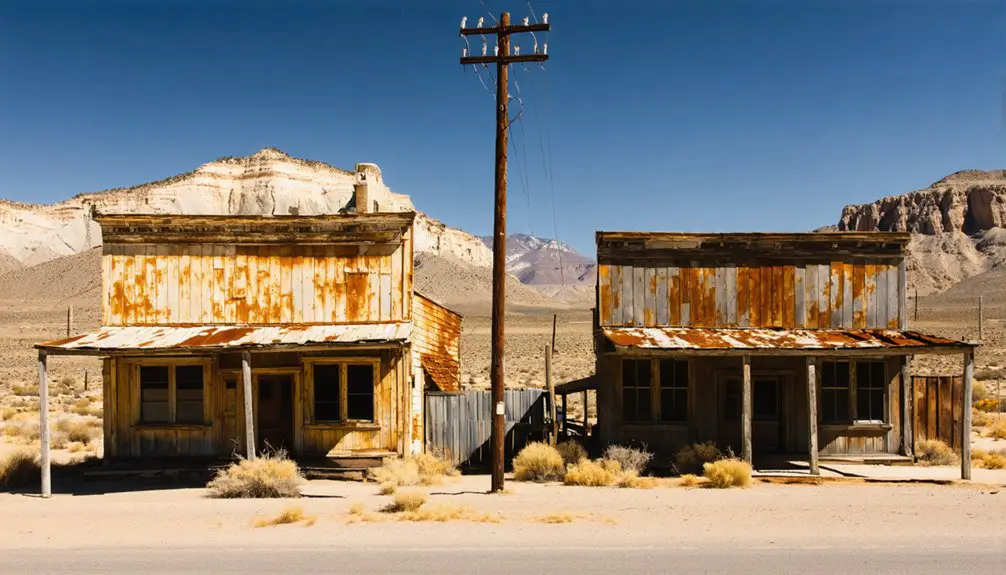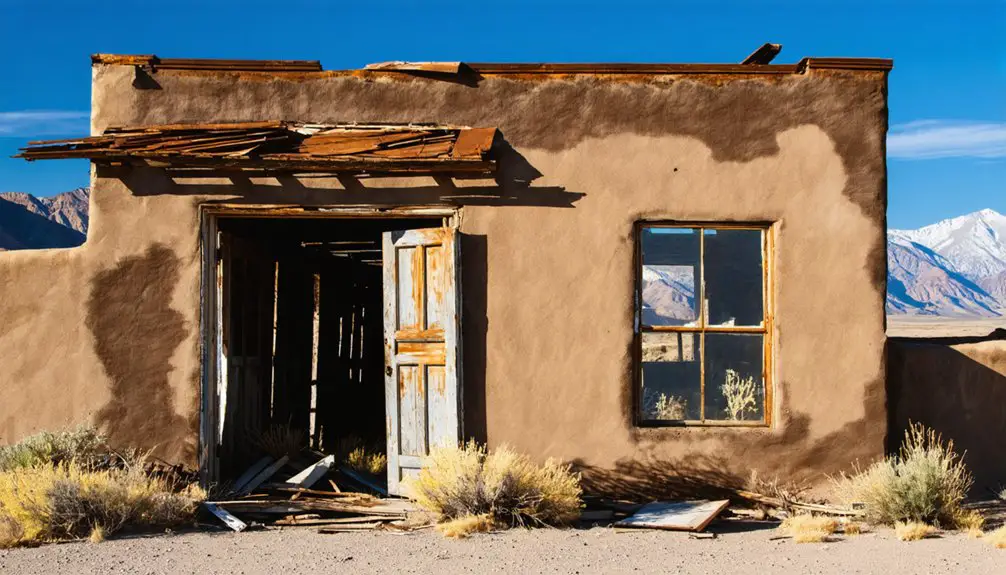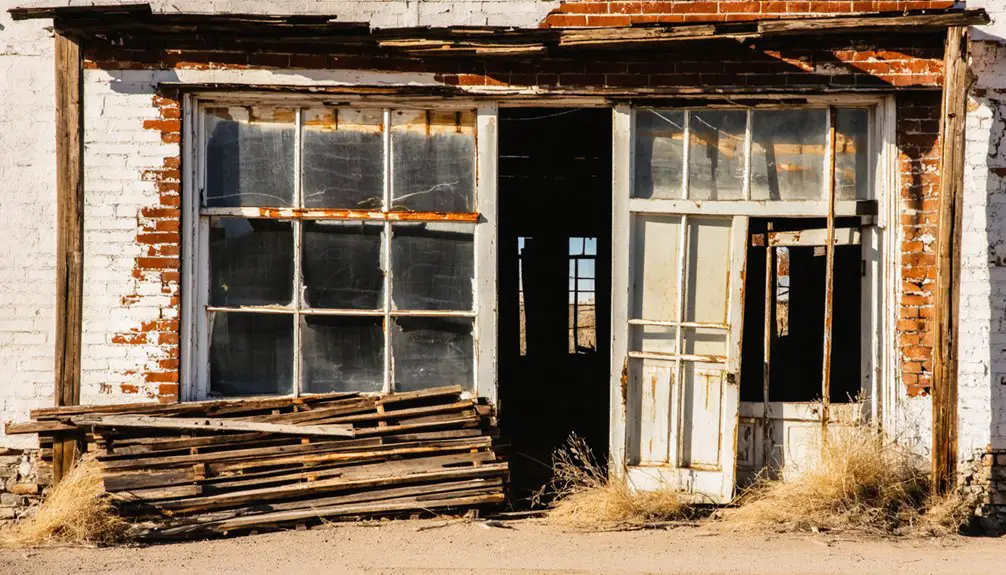You’ll find Newhouse, Utah—an ambitious silver mining settlement founded in 1905 by mining magnate Samuel Newhouse—standing as weathered ruins in Beaver County’s desert landscape, about 42 miles west of Milford. The company town once boasted modern amenities, seventy stucco houses, and Utah’s first steam shovel, thriving until 1919’s post-war mineral market collapse forced its closure. Today, sun-bleached foundations, crumbling stone structures, and scattered artifacts tell a deeper story of this carefully planned community’s rise and fall.
Key Takeaways
- Newhouse was a mining town established in 1905 by Samuel Newhouse, who invested $2 million to develop a modern company town.
- The town featured 70 stucco houses, cultural venues, and modern amenities including Utah’s first steam shovel for mining operations.
- Mining operations focused on silver extraction from the Cactus Mine until economic pressures forced Newhouse to sell in 1910.
- The post-war mineral market collapse in 1919 led to the town’s abandonment, with buildings relocated to nearby Milford.
- Today, only foundations, crumbling stone houses, and roofless buildings remain as remnants of the once-thriving mining community.
The Birth of a Silver Mining Dream
While many early mining ventures in Utah’s rugged terrain ended in disappointment, the discovery of the Cactus Mine in 1870 marked the beginning of silver mining aspirations in the San Francisco Mining District.
The arrival of the Utah Southern Railroad in 1880 brought new hopes of development to the region.
You’d find a settlement known as Tent Town, where determined miners lived in temporary shelters, dreaming of striking it rich in this promising location.
Despite the area’s potential, early attempts to establish profitable silver mining operations proved challenging.
The promise of silver riches proved elusive as miners struggled to establish successful operations in the unforgiving Utah landscape.
For three decades, various companies tried and failed to make the mine profitable. Even the construction of a small smelter in 1892 couldn’t turn the tide.
Operations remained sporadic and financially unstable until 1900, when Samuel Newhouse’s purchase would transform this struggling venture into one of Utah’s notable ghost towns. Like many entries on Wikipedia’s disambiguation pages, the story of Newhouse required careful organization to distinguish it from other similarly named locations.
Samuel Newhouse’s Vision and Investment
After establishing his fortune through successful copper ventures in Utah’s Bingham District, Samuel Newhouse set his sights on the struggling Cactus Mine in 1905, investing a remarkable $2 million to transform it into a modern mining operation.
His entrepreneurial vision went far beyond mere mineral extraction. You’ll find he built an entire company town, complete with modern amenities that were rare for the era. The town of Newhouse soon boasted comfortable homes, stores, a hospital, library, and even an opera house. His extravagant lifestyle was evident in the town’s grand architecture and amenities.
He introduced cutting-edge technology, including Utah’s first steam shovel at the Cactus group. Much like his earlier success with the Highland Boy Mine in 1896, Newhouse demonstrated his ability to identify and develop promising mining properties. Despite these ambitious investments and innovations, mounting debts and the financial pressures of 1910 forced Newhouse to sell and abandon both the town and mines, leaving behind a reflection of his bold mining dreams.
Life in a Company Town
Life in Newhouse epitomized the classic company town model of the early 1900s, where the mining corporation controlled nearly every aspect of residents’ daily existence.
You’d find yourself living in one of seventy stucco houses built for worker accommodation, all under strict company policies that governed your behavior and living conditions. The town was developed by Standard Oil Company, which had acquired the mining operations for $12 million.
While the company provided modern amenities like electricity, water, and cultural venues, you’d notice their tight control everywhere. You couldn’t drink publicly within town limits – the saloon was banished a mile away. The water supply came from Wawa Springs to support both mining operations and household needs.
Yet you’d benefit from the town park, hospital, and opera house, all carefully planned by Samuel Newhouse. The company even gave Christmas presents to children and offered prizes for the first town birth, demonstrating their paternalistic approach to community management.
Mining Technology and Infrastructure
At Newhouse’s mill operations, you’ll find evidence of early industrial innovation through its shift from steam to electric power, which increased efficiency across the mining complex. The Telluride Power Company supplied the electricity that enabled this modernization in 1907. The introduction of flotation processes helped maximize mineral extraction from the ore.
The site’s sophisticated rail infrastructure included both a private 3-mile narrow gauge railroad with a 65-ton Shay locomotive and a 7-mile branch line extension by San Pedro, Los Angeles & Salt Lake Railroad.
You can trace the evolution of ore processing technology through the mill’s expansion from an 800-ton daily capacity in 1905 to 1,000 tons by 1909, showcasing the rapid advancement of mining capabilities in early 20th century Utah.
Steam Shovel Pioneer Site
The historic Steam Shovel Pioneer Site marked a significant technological breakthrough in Utah’s mining history when the first Vulcan steam shovel began operations at the Cactus group near Newhouse in 1904.
You’ll find that this pioneering mechanized mining site expanded rapidly, with four Marion steam shovels added by 1907, revolutionizing surface excavation methods.
Similar to how early Plain City settlers used V-shaped scrapers to build canals, the site’s infrastructure supported these groundbreaking machines through an efficient three-mile private railroad network that connected the mine to its 1,000-ton capacity mill.
Samuel Newhouse established the Highland Boy Company in 1896, setting the foundation for modern copper mining operations in the region.
You can trace how steam shovels transformed mining from labor-intensive manual work to large-scale commercial copper production.
This technological advancement helped establish Newhouse as a major copper producer, with the mining operation later upgrading to electric power for its mill, compressors, and hoists – a reflection of the site’s innovative spirit.
Railroad and Mill Operations
Operating from September 1904, Newhouse’s extensive rail network revolutionized copper mining operations through an ingeniously designed system of interconnected lines.
The railroad expansion included a seven-mile branch line to Frisco mine and a private three-mile track linking the mine to the mill.
You’ll find the heart of operations centered around an 800-ton concentrating mill, later upgraded to process 1,000 tons daily through mill modernization efforts in 1909.
- A powerful 65-ton Shay locomotive tackled steep grades and sharp curves
- Standard gauge track enabled seamless connection to major rail networks
- Electric power replaced steam, driving mill equipment and compressors
- Direct rail-to-mill transport maximized operational efficiency
- Water piped from Wah Wah Springs supported both mining and community needs
The integrated system operated until the 1930s, when operations ceased and track removal began in 1937.
The Social Fabric of Newhouse

You’ll find that Newhouse’s social fabric was carefully cultivated through Samuel Newhouse’s vision of an orderly mining town, complete with structured community rules and organized gatherings at the brick clubhouse.
The town’s cultural life centered around its dance hall, library, and restaurant, where residents could escape the daily rigors of mining work and build lasting social bonds.
These venues served as the heartbeat of the community until 1914, when the dismantling of the Cactus Mill triggered the town’s rapid decline and eventual abandonment.
Community Rules and Control
While many frontier mining towns developed organically, Newhouse emerged as a carefully controlled community under Samuel Newhouse’s $2 million investment and direct oversight.
The town’s community governance reflected a clear social hierarchy, with management maintaining order through economic and social control measures.
- Rules centered around mining operations and productivity
- Social spaces like dance halls and clubhouses provided controlled entertainment
- Monetary incentives encouraged stable family settlement
- Strong room or vault symbolized centralized financial control
- Library and communal facilities reinforced desired social behaviors
You’d find life in Newhouse structured around the company’s interests, with your daily activities influenced by the town’s carefully planned infrastructure and social institutions.
From the stucco homes to the communal gathering spots, every aspect of town life operated under management’s watchful eye, balancing worker productivity with community stability.
Town Entertainment and Culture
Unlike typical rowdy mining towns of the era, Newhouse cultivated a refined cultural atmosphere through its carefully planned entertainment venues and social spaces.
You’d find yourself immersed in a vibrant social scene centered around the opera house and dance hall, where cultural events and community gatherings regularly took place.
The well-appointed clubhouse offered billiards and a library for your intellectual pursuits, while the café and restaurant served as social hubs where you could connect with neighbors.
The town even sparked excitement with unique incentives, like offering a fifty-dollar prize to the first couple to have a baby in Newhouse.
Without the distractions of saloons or gambling houses, residents focused on family-oriented entertainment and social activities that strengthened community bonds.
Economic Rise and Fall
In the early 1900s, Samuel Newhouse‘s $2 million investment transformed a barren Utah landscape into a thriving copper mining town. The town’s economic sustainability relied heavily on the Cactus Mine, which flourished until 1910.
Despite the mining dependency, Newhouse boasted modern amenities including electricity, piped water, and over 70 company homes.
- Initial boom created diverse infrastructure: cafe, library, hospital, stores, hotel
- Advanced 700-ton flotation mill pioneered regional mineral processing
- World War I brought $120,000 in profits from processing mine tailings
- Post-war mineral market collapse forced closure in 1919
- Buildings were relocated to Milford, 30 miles away, as residents departed
The town’s fate was sealed by depleted ore deposits and volatile metal markets, proving that single-industry economies rarely survive resource exhaustion.
What Remains Today

Modern visitors to Newhouse encounter a haunting collection of sun-bleached foundations and deteriorating structures spread across the former townsite.
You’ll find structural remnants including a crumbling stone house, several roofless block buildings, and the ruins of what was once a prominent brick structure. The foundations of the town’s dance hall, library, clubhouse, hotel, and hospital remain visible among the scattered debris.
Historical artifacts litter the desert landscape, with glass shards and rusted metal pieces concentrated along former roadways.
Scattered bits of history dot the sandy trails – broken bottles and oxidized metal remnants marking paths of the past.
You’ll want to bring a metal detector, as the site’s loose soil and erosion patterns suggest many relics lie buried beneath the surface.
The harsh desert environment at 5,151 feet elevation has taken its toll, leaving this once-bustling mining town open to the elements and natural decay.
Planning Your Visit to the Ghost Town
Planning a successful visit to Newhouse requires careful preparation due to its remote desert location. You’ll find the ghost town about 30 miles west of Milford on UT-21, with the final approach requiring a 2-mile drive on a side road.
For proper visitor preparation and safety, make sure you’ve got a full tank of gas, plenty of water, and a charged cell phone before heading out.
- Drive a high-clearance vehicle to navigate rough terrain
- Pack essential supplies – there are no services or facilities on-site
- Wear sturdy hiking boots and sun protection gear
- Bring a metal detector to search for historical artifacts
- Stay on main paths to avoid hazards like rusted nails and unstable structures
Frequently Asked Questions
Are There Any Documented Accidents or Deaths at the Cactus Mine?
You won’t find documented accidents or deaths specifically at the Cactus Mine in available records, though mining safety concerns were common in Utah’s history, with numerous fatal incidents occurring regionally in Carbon County.
What Happened to Samuel Newhouse After the Town’s Abandonment?
You’ll find Samuel Newhouse thrived after the town’s abandonment, focusing on Salt Lake City development with his iconic skyscrapers and hotels, while maintaining multiple luxury residences abroad until his eventual death.
Were Native American Artifacts Ever Found in the Newhouse Area?
While you’ll find rich native heritage throughout Utah, there’s no direct evidence of artifact discovery specifically in Newhouse, though nearby areas have yielded typical Southwestern Native American artifacts.
Did Any Famous People Visit or Stay in Newhouse?
You won’t find records of any famous visitors or celebrity sightings in the town beyond Samuel Newhouse himself, the wealthy entrepreneur who founded and developed this mining community in 1900.
How Did Winters Affect Mining Operations and Daily Life?
You’d face severe winter hardships that froze equipment, delayed ore transport, and disrupted daily mining. Your community struggled with isolation, limited supplies, and the constant battle against cold in stucco homes.
References
- https://en.wikipedia.org/wiki/Newhouse
- https://figshare.le.ac.uk/articles/thesis/The_Archaeology_of_Abandonment_Ghost_Towns_of_the_American_West/10120007
- http://www.expeditionutah.com/forum/index.php?threads/ghost-town-newhouse.4727/
- https://utahrails.net/mining/newhouse.php
- https://www.utahoutdooractivities.com/newhouse.html
- https://www.jmaw.org/newhouse-jewish-utah/
- https://www.uen.org/utah_history_encyclopedia/n/NEWHOUSE_SAMUEL.shtml
- https://historytogo.utah.gov/silver/
- https://www.mappingslc.org/this-was-here/item/61-salt-lake-stock-and-mining-exchange
- http://www.jewishleadville.org/newhouse.html



